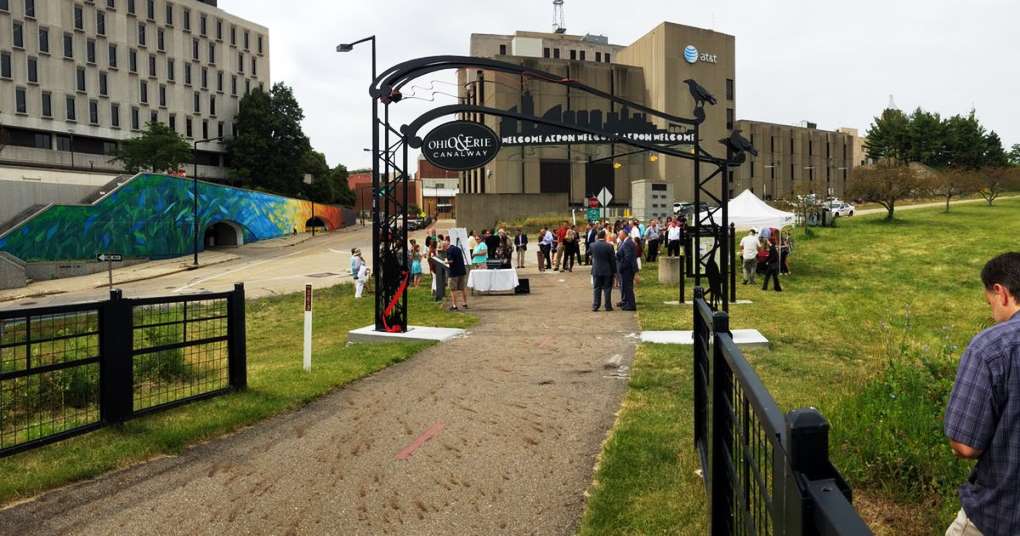As American communities face increasing levels of social and economic division, a new report showcases how five U.S. cities are reimagining public spaces—parks, trails, plazas, libraries—to bring residents together and revive neglected neighborhoods.
The report, “Common Goals, Different Approaches,” commissioned by the John S. and James L. Knight Foundation, traces projects in Akron, Ohio; Chicago; Detroit; Memphis, Tennessee; and Philadelphia to revitalize and connect civic assets as a means to influence positive social and economic outcomes.
“The journey to create great public spaces is unique for each city, but the goal is the same: to strengthen community connection, trust and engagement,” said Sam Gill, Knight Foundation vice president for communities and impact. “While there’s no one-size-fits-all approach to revitalize and connect civic assets, these case studies show the most successful strategies are those shaped by resident insights and involvement.”
The efforts are part of Reimagining the Civic Commons (RCC), a three-year, national initiative that formally launched in 2016 with $20 million in support from The JPB Foundation, Knight Foundation, The Kresge Foundation and The Rockefeller Foundation, plus another $20 million in matching funds from local partners. The initiative was piloted in Philadelphia in 2015 with $11 million in support from Knight Foundation and the William Penn Foundation.
With two-thirds of the RCC initiative complete, the report provides a qualitative look at the successes and challenges experienced by the participating cities so far. It offers lessons learned for other communities exploring the potential of public spaces to connect residents of all backgrounds, foster civic engagement, advance environmental sustainability and promote economic development.
The report details progress made in each of the cities:
- In Philadelphia, the first city to participate in RCC and conclude its RCC program, five new civic assets were created, including parks, trails and a library, each connected to evolving neighborhoods. RCC broke down perceived barriers between natural landmarks and neighborhoods, and made residents feel welcome for the first time at previously neglected sites. The city is now applying lessons learned from RCC to other projects, including Rebuild, a $500 million citywide neighborhood revitalization program.
- In Detroit, RCC efforts are redefining vacancy as an asset and changing residents’ perceptions of city government, which is leading the initiative in collaboration with nonprofit and neighborhood partners. The city has garnered new trust from residents by engaging them in the projects’ development and by investing in its planning department, growing from six city planners in 2015 to 36 today, to deliver on residents’ expectations. The results point to a new model for neighborhoods across the city, tackling vacancy and blight. So far, the project, centered in the Fitzgerald neighborhood, has turned empty lots into a neighborhood park, rehabbed houses and reactivated the commercial corridor with new store fronts.
- In Memphis, partners are leveraging the city’s riverfront to bring vibrancy back to downtown by creating a space welcoming to all. Through grassroots community engagement efforts, the project is overcoming legacy local issues—economic disparity, segregation and concerns that the downtown area is unsafe and unwelcoming—and writing a new neighborhood narrative.
- In Akron, the smallest city participating in RCC, project leaders are prototyping with small-scale projects, informed by and in partnership with residents, setting the stage for a large, collective impact in the long-term. Downtown Akron continues to struggle with population loss that began decades ago, with many people only driving in and out for work. RCC is slowly changing this dynamic by investing in isolated neighborhoods and the Ohio & Erie Canalway Towpath Trail that connects them. In addition to reestablishing the 100-acre Summit Lake as an inviting public space, RCC is making Akron a more attractive place to live, work and play for current and potential residents alike.
- In Chicago, renowned local artist Theaster Gates, who leads the city’s RCC project and manages most of the properties involved through his nonprofits, is using the arts and culture to turn underutilized assets on the South and West sides of Chicago into vibrant civic places. A cultural district is in the making, aimed at fostering opportunity for residents in historically underserved neighborhoods. The remodeled Stony Island Arts Bank, a former financial building, is at the heart of the master plan, with additional RCC projects underway to transform and connect nearby vacant assets.
The report follows a series of quantitative assessments shared last week by Reimagining the Civic Commons that track changes in the social impacts of improved public spaces in the participating cities, excluding Philadelphia. The interim data show that investments in public spaces have improved residents’ perceptions of neighborhoods, with many reporting they feel safer and more optimistic about the future of the areas.
“Reimagining the Civic Commons is an experiment to explore the potential of public spaces to bridge divides and build more resilient communities,” said Lynn Ross, Knight Foundation’s lead consultant for its work supporting RCC. “The experiment is one from which we will never stop learning, and the more outcomes shared, the better. As cities undertake new public space initiatives, it’s invaluable to learn from the good and the bad of efforts gone before, such as those highlighted in Knight’s new report.”
Photo of Akron, Ohio is courtesy of Summit Metro Parks.
Learn more about the report, “Common Goals, Different Approaches,” by reading this blog.

